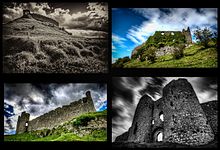Castle Roche
| Castle Roche | ||
|---|---|---|
|
The ruins of Castle Roche from the northwest |
||
| Alternative name (s): | Dún Gall | |
| Creation time : | 1226 | |
| Castle type : | Hilltop castle | |
| Conservation status: | ruin | |
| Standing position : | Irish nobility | |
| Construction: | Quarry stone | |
| Place: | Dundalk | |
| Geographical location | 54 ° 2 '47.2 " N , 6 ° 29' 18.2" W | |
| Height: | 42 m ASLTemplate: height / unknown reference | |
|
|
||
Castle Roche (also Roche Castle , Irish Dún Gall ) is the ruins of a hilltop castle from Norman times about 10 km northwest of Dundalk in the Irish County Louth . The castle was the seat of the De Verdun or De Verdon family who built the castle in 1236. It is considered a national monument .
Castle Roche sits on a large rocky outcrop and offers sweeping views of the surrounding land. Together with a deep moat , their strong walls made them almost impassable. A secret passage once connected the castle with an outpost in a round tower . The Roman's Well is very close.
history
The De Verdun family of Alton Castle in Staffordshire played a role in the history of the area, as Bertram de Verdun came to Ireland on King John Ohneland's first expedition . In 1185 he had a mansion built on Castletown Mount and in 1189 received the town's charter.
Bertram de Verdun's granddaughter Rohesia from Alton Castle in England was married to Theobald le Bottelier, 2nd Chief Butler of Ireland . After the sudden death of her husband on a trip to Poitou in France , the widow moved to her lands in Ireland. She immediately began to fortify these lands with a castle. Legend has it that their fickleness put off all possible architects; she offered her hand (and with it part of her wealth) to the man who built a castle according to her wishes. The legend continues that after the wedding feast in the castle that was just completed, she asked her husband into her bridal chamber and urged him to look at her possessions from the large bedroom window. She pushed her new husband out the window and he fell to his death. This window was then called the "murder window". Rohesia became a nun at Gracedieu Abbey in Leicestershire , died in 1247 and was buried in the nearby parish church of Belton , where her tomb can still be seen today. Even if it is generally assumed that Rohesia commissioned the construction of the castle, her son, Theobald John , had most of it added. The name "Castle Roche" comes from its location; roche is the French word for rock.
The castle was in a strategically important location on the border between the (then) exclusively Gaelic province of Ulster and the territory called Pale, which was controlled by the Anglo- Normans . She watched over the road to what is now South Armagh . The De Verdon family held the castle for many years. Nicholas de Verdon († 1316) lived there at the time of the incursion of Edward Bruce , the brother of the Scottish King Robert the Bruce . In 1561 all the English troops met there, but in 1641, when Ireland was retaken , the castle was finally destroyed.
Individual evidence
- ↑ 1260s - Castle Roche, Co. Louth . In: Archiseek . Retrieved March 12, 2019.
- ^ De Verdun Family Group: John De Verdun; son of Rohese De Verdun; daughter of Nicholas De Verdun; son of Bertram De Verdun . Retrieved March 14, 2019.
- ^ Castle Roche . Iol.ie. Retrieved March 14, 2019.
- ↑ Section 1: The de Verdun (1027-1316) . Retrieved March 14, 2019.


